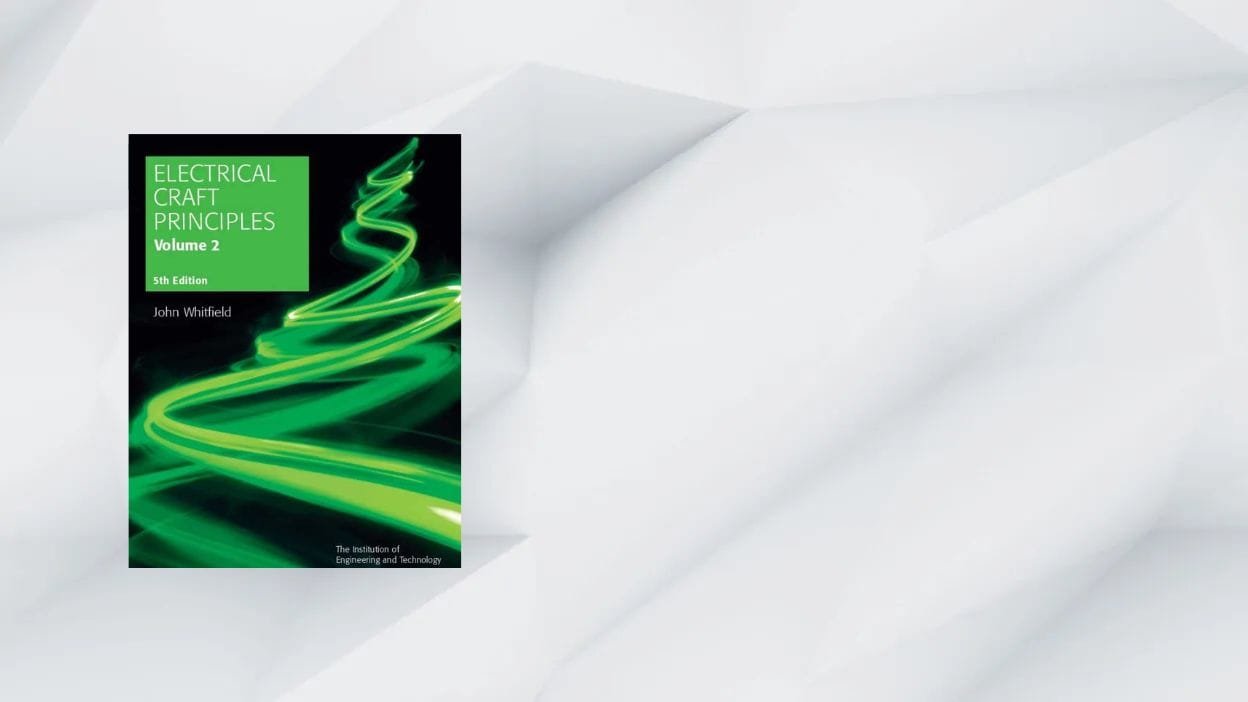Few textbooks serve UK and Commonwealth electrical-craft courses as faithfully as Electrical Craft Principles Volume 2 5th Edition by John Whitfield. Published in 2009 by the Institution of Engineering & Technology (IET), this 344-page green-jacketed volume completes the two-part series that underpins City & Guilds, BTEC and apprentice curricula.
Book at a Glance
| Title | Electrical Craft Principles Volume 2 5th Edition |
| Author | John Whitfield |
| Publisher / Year | IET • March 2009 |
| Print length | 344 pages |
| Series | Materials, Circuits and Devices |
| Typical price range | £50–£60 (print) – no link provided |
| Core audience | Electrical craft students, apprentices, Level 3-4 technicians |
Why the Fifth Edition Still Matters
- Syllabus alignment – Explicitly written to cover City & Guilds electrical-craft units and the first three years of BTEC electrical routes.
- Worked-example richness – More than 90 fully solved problems plus 300+ end-of-chapter questions turn theory into calculation muscle memory.
- Bridge between craft and technician – Topics scale from capacitor basics to synchronous-motor theory, easing the jump to higher-level study.
- Plain-English explanations – Whitfield’s concise prose demystifies phasors, transformer equivalent circuits and motor characteristics without drowning beginners in algebra.
Chapter Snapshot
| Chapter | Theme | Skills You’ll Gain |
|---|---|---|
| 1 | Capacitance & Capacitors | Reactive-energy storage, time constants |
| 2 | Inductance & Inductors | Flux linkage, L / dI/dt relationships |
| 3 | Magnetic Materials & Core Loss | Hysteresis curves, loss calculations |
| 4 | AC Theory | Phasors, impedance, resonance |
| 5 | Power in AC Circuits | Real vs reactive kVA, power factor correction |
| 6 | Further Electronics | Diodes, SCRs, basic rectifiers |
| 7 | Transformers | Equivalent circuits, efficiency tests |
| 8 | Generator Principles | EMF equation, winding factors |
| 9 | DC Machines | Armature reaction, speed control |
| 10 | AC Motors | Induction & synchronous operation |
| 11 | Measuring Instruments | Moving-coil, moving-iron meters |
| 12 | Lighting | Lumen method, discharge-lamp starters |
| 13 | Supply Economics | Tariffs, demand factors, load curves |
Real-World Strengths
- Exam-ready structure – Each section ends with revision questions mirroring City & Guilds multiple-choice formats.
- Numerical clarity – SI units throughout; answers provided, so self-learners can verify progress quickly.
- Illustrative line art – Clean diagrams of winding layouts, phasor circles and instrument internals aid visual learners.
- Continuity with Volume 1 – Picks up exactly where the first book leaves off, eliminating duplication and gaps.
Limitations to Note
| Limitation | Impact | Quick Work-around |
|---|---|---|
| 2009 publication date | Omits LED driver circuits and EV-charger topics | Supplement with current IET guidance notes |
| Imperial units scarce | May slow USA learners | Keep a metric-imperial conversion sheet handy |
| No digital resources | No online quizzes or videos | Pair with free simulation tools (e.g., Tinkercad Circuits) |
Who Should Read Electrical Craft Principles Volume 2 5th Edition?
- Level 3-4 apprentices needing a single text for both classwork and on-site study.
- College lecturers looking for ready-made problem sets aligned to UK awarding-body outcomes.
- Self-study candidates preparing for JIB or NVQ assessments who want step-by-step numericals.
- Technicians bridging to HNC/HND courses and needing a refresher on rotating machines and transformer theory.
SEO-Friendly FAQ
Is Electrical Craft Principles Volume 2 5th Edition beginner-friendly?
Yes. It assumes Volume 1 basics but revises key formulae before advancing to motors and power factor.
Does the book match the latest 18th-Edition Wiring Regulations?
While calculation methods remain valid, always cross-check final designs with current BS 7671 tables.
Are solutions included?
Odd-numbered answers are printed; full worked solutions appear in the companion tutor pack often issued to colleges.

